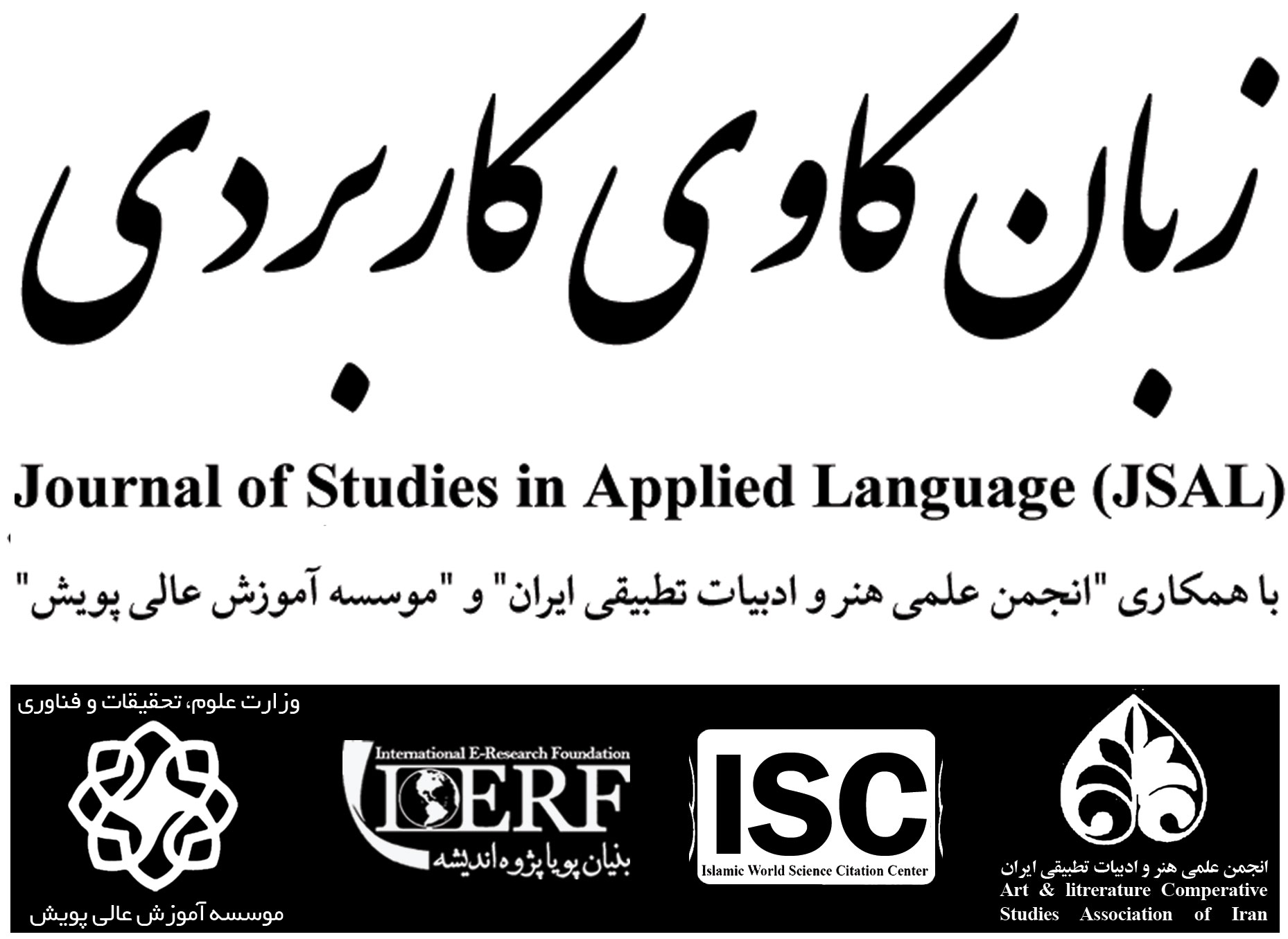دوره 6، شماره 1 - ( 12-1401 )
جلد 6 شماره 1 صفحات 148-123 |
برگشت به فهرست نسخه ها
Download citation:
BibTeX | RIS | EndNote | Medlars | ProCite | Reference Manager | RefWorks
Send citation to:



BibTeX | RIS | EndNote | Medlars | ProCite | Reference Manager | RefWorks
Send citation to:
Vaezi H, Taghipour Bazargani D. (2023). A Linguistic Study of Types of Repetition in Persian Legal Bills [In Persian]. JSAL. 6(1), 123-148. doi:10.52547/jsal.6.1.128
URL: http://jsal.ierf.ir/article-1-26-fa.html
URL: http://jsal.ierf.ir/article-1-26-fa.html
واعظی هنگامه، تقی پور بازرگانی داوود.(1401). بررسی زبانشناختی انواع تکرار در لایحههای حقوقی فارسی زبان کاوی کاربردی 6 (1) :148-123 10.52547/jsal.6.1.128
1- استادیار گروه زبان انگلیسی و زبانشناسی، واحد رشت، دانشگاه آزاد اسلامی، رشت، ایران ، hengamehvaezi@yahoo.com
2- استادیار گروه زبان انگلیسی، واحد رشت، دانشگاه آزاد اسلامی، رشت، ایران
2- استادیار گروه زبان انگلیسی، واحد رشت، دانشگاه آزاد اسلامی، رشت، ایران
چکیده: (5074 مشاهده)
بی تردید آنچه متن را یکپارچه و از نوشتههای پراکنده متمایز می سازد، انسجام است و نقش آن درواقع برقراری رابطه بین دو قسمت از متن و تداوم بخشیدن به آن بوده تا بدینوسیله، خواننده یا شنونده عناصر ناموجود در متن را که برای تعبیر آن ضروری هستند، دریابد. از ابزارهای انسجام میتوان به ارجاع، جایگزینی و حذف، حروف ربط یا پیوندی (انسجام دستوری) و تکرار و همآیندی (انسجام واژگانی) اشاره کرد. بررسی زبانشناختی می تواند بر روی متون شفاهی حقوقی (مانند گفتمان داخل دادگاه) و متون کتبی حقوقی (نامه ها، اسناد، لوایح، و پرونده ها) در سطوح مختلف تمرکز کند. زبانشناسی حقوقی که محکمه ای نیز خوانده می شود یکی از شاخه های بینا رشتهای بین زبانشناسی و حقوق قضایی است. تکرار به عنوان یکی از ابزارهای تخمین انسجام متن، ماهیتاً با زبان ارتباط دارد؛ پژوهش حاضر به بررسی زبانشناختی انواع تکرار در لوایح حوقی فارسی می پردازد. در بررسی کاربردی متون حقوقی، زبانشناسان با بررسی اسناد، شهادت در دادگاه ها، واژه های خاص کلام مجرمان، نوع سبک گفتاری و نوشتاری در پرونده های قضایی نظر کارشناسی می دهند. یکی از مسائلی که فراوان در متن های حقوقی بهطور خاص لایحه ها به چشم می خورد، پدیده سبکی تکرار اطلاعات است. داده ها از 40 لایحه ارائهشده در دادگاه ها جمع آوری و با روش کیفی تحلیلشدهاند. بررسی نمونه ها نشان می دهد که متن نوشتاری لایحه ها از دو گروه اصلی تشکیل می شود؛ تکرار بیفایده و تکرار مفید. در گروه اول، عبارت های تکراری اطلاعات غیرضروری هستند که حشو در نظر گرفته می شوند و در متون مورد بحث حقوقی مشاهده شدند. گروه دوم، از دو زیر طبقه تکرارهای دستوری و بافتی تشکیل می شود. تکرارهای دستوری بر مبنای ضرورت قواعد زبان فارسی شکلگرفتهاند و اجباری هستند. تکرارهای بافتی به اقتضای متن و سبک نوشتاری حقوقی انواع متفاوتی را نشان می دهند که عبارتند از: تکرار عین واژه، تکرار مترادف، تکرار واژه های مخالف، تکرار متمایزکننده و تکرار برجسته ساز. دوبارهنویسی مطالب، جملات پیچیده، عدم توجه به نقطه گذاری، کاربرد قیود متعدد، همپایگی های طولانی و فعل های چندبخشی از ویژگی های خاص متون مورد بررسی است. تکرار اطلاعات در لایحه ها با انگیزههای تأکید، ترس از فراموشی مخاطب در طولانی شدن کلام و یادآوری نکات کلیدی ارتباط دارد؛ بنابراین تکرار اطلاعات در این متون نقش کاربردی و مؤثری دارد و سبب سهولت انتقال پیام اصلی می شود.
واژههای کلیدی: زبان شناسی حقوقی، زبان شناسی محکمهای، لایحه حقوقی فارسی، تکرار دستوری، تکرار بافتی، حشو، زبان شناسی اجتماعی
نوع مطالعه: پژوهشي |
موضوع مقاله:
زبان شناسی اجتماعی
دریافت: 1400/11/10 | پذیرش: 1401/8/8 | انتشار: 1401/12/10
دریافت: 1400/11/10 | پذیرش: 1401/8/8 | انتشار: 1401/12/10
فهرست منابع
1. Staji, A., (2005). "Legal Linguistics", Journal of Linguistics, Vol. 20, No. 2, pp. 163-174.
2. Estaji, A. (2006). "Introducing Forensic phonetics and some of its applications". Language and Linguistics, Vol. 2, No. 4, pp. 149-156.
3. Agha golzadeh, F., (2007). "Legal Linguistics: A New Approach in Applied Linguistics", Bukhara, No. 63, pp. 192-204.
4. Batani, M., (1991). Description of the grammatical structure of the Persian language, 4th edition, Tehran: Amirkabir Publications.
5. Palmer, F., (1976). A New Look at Semantics, translated by Koresh Safavi, Center Publishing.
6. Khosrovi zadeh, P., (2005). "Looking at the phenomenon of lexical stuffing from the point of view of absolute coherence", a collection of papers of the first conference of the Iranian Linguistics Association, pp. 353-362.
7. Khosravi zadeh, P. (2009). "Redundancies in conversation: a study on the process of producing and understanding". Language and Linguistics, Vol. 5, No. 9, pp. 33-48.
8. Daneshgar, M., (2004). "Pleonasm in today writings". LIRE 2003; Vol. 1, No. 4, pp. 83-114.
9. Rasekhmahand, M. (2010). "Persian Clitics beside Verbs". Journal of Researches in Linguistics, Vol. 2, No. 3, pp. 75-85
10. Rovshan, B., & Behboudi, S. (2009). "Description of Syntactic and Lexical Properties of Persian Civil Law Texts". Language and Linguistics, Vol. 5, No. 9, pp. 105-136
11. Sami Gilani, A., (2001). Writing and editing, 3th Edition, Samt Publications.
12. Sami Gilani, A., (2016) Writing Rules, 13th Edition, Academic Publishing Center.
13. Safavi, K., (1994). From Linguistics to Literature, 1th Edition, Tehran: Research Institute of Islamic Culture.
14. Farazande pour, F., (2008). Pathology of legal texts from the Point of View of Linguistics and Presenting a Model based on the analysis of thematic construction: the approach of legal linguistics, thesis for the master's degree in Linguistics, Tarbiat Modares University.
15. Kurd alivand, R., (2012). "Legal Linguistics", Human and Culture, Special Issue on Language and Text, Vol 2, No 3, pp. 5-16.
16. Lazar, G., (2013). Modern Persian Grammar, translated by Mehsti Bahreini, Tehran: Hermes Publishing.
17. Latifi Khah, P., (2002). examining the syntactic structure of the civil law text, master's thesis, Islamic Azad University, central Tehran branch.
18. Madrasi, Y., (2013). Introduction to Sociology of Language, Research Institute of Humanities and Cultural Studies, Tehran.
19. Hyman, Larry. M. (1975). phonetic system of language: theory and analysis, translated by Yadullah Samrah, Farhang Maazer.
20. Brown. G. & Yule. G. (1983). Discourse analysis. Cambridge: Cambridge University. [DOI:10.1017/CBO9780511805226]
21. Buşila, A. (2017). The issue of translating legal doublets in notarial acts from English into Romanian. Lingua Legis, pp. 123- 136.
22. Campbell, J. (1982). Grammatical man, information, entropy, language, and life. New York: Simon and Schuster.
23. Chromà, M. (2011). Synonymy and polysemy in legal terminology & their applications to bilingual & bijural translation". Research in Legal, Vol. 9, No. 1, pp. 31-50. Doi: 10.2478/v10015-011-0004-2 [DOI:10.2478/v10015-011-0004-2]
24. Grice, H. P. (1975). Logic and conversation. Syntax and Semantics, 3th Edition, by P. Cole and J. Morgan, Academic Press. Reprinted as ch.2 of Grice 1989, pp. 22-40. [DOI:10.1163/9789004368811_003]
25. Halliday, M. A. K. (1985). An Introduction to functional grammar. Edward Arnold, London.
26. Halliday, M. A. & Hassan, R. (1976). Cohesion in English. New York: Longman.
27. Halle, M. (1971). The sound pattern of Russian. The Hague: Mouton. [DOI:10.1515/9783110869453]
28. Hassan, R. (1979). On the notion of text. In J. S. Petofi(ed.), Text vs. sentence: Basic question of text linguistics, Helmet Busk, Humburg.
29. Hunnicutt, S. (1985). "Intelligibility versus redundancy". Language and Speech, Vol 28, No 1, pp 47-56. Doi: 10.1177/002383098502800103 [DOI:10.1177/002383098502800103]
30. Shannon, C. E. (1948). "A mathematical theory of communication". The Bell System Technical Journal, Vol. 27, No. 3, pp. 379-423. Doi: 10.1002/j.1538-7305.1948.tb01338.x [DOI:10.1002/j.1538-7305.1948.tb01338.x]
31. Tiersma, P. (2001). "The creation, structure and interpretation of the legal text". www.languageandlaw.org //LEGALLANG/ LEGALLANG.HTM.
32. Tiersma, P. (2005) "Correction and addition to legal language". www.tiersma.com//CORRECT.HTM.
33. Wit, C. E. & Gillette. M. (1999). What is linguistic redundancy?. Technical Report, The University of Chicago. 1-17. The paper is fully available on:
34. http://www.math.rug.nh/~ernst/linguistics/redundancy3.pdf
ارسال پیام به نویسنده مسئول
| بازنشر اطلاعات | |
 |
این مقاله تحت شرایط Creative Commons Attribution-NonCommercial 4.0 International License قابل بازنشر است. |








